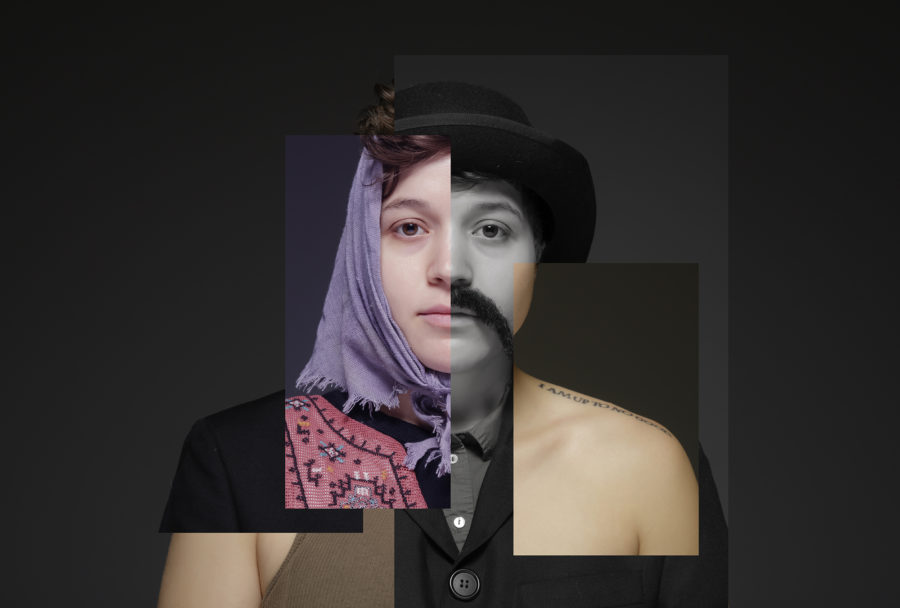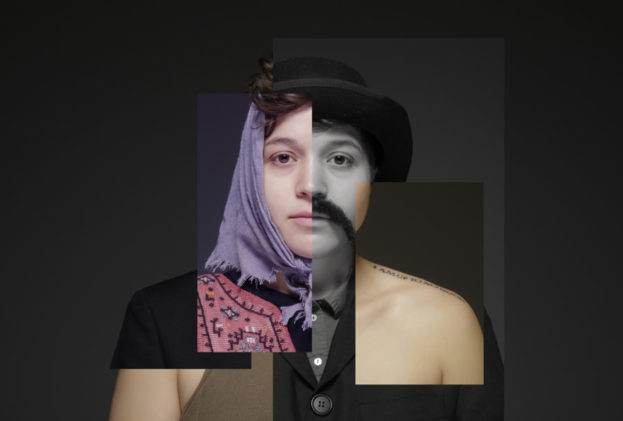
When a dance company reaches its 30th birthday, this is cause for celebration. It usually means they’ve managed to stay afloat in unstable economic periods, weathered artistic storms, and nurtured fertile working environments for decades.
In the case of the Joe Goode Performance Group, which performs its 30th anniversary season in June at Yerba Buena Center for the Arts, there’s extra cause for celebration. A distinguishing factor of the Group is its longterm relationships: dancer Marit Brook-Kothlow has been with the Group since 1990, and Felipe Barrueto-Cabello since 1996. At YBCA they will perform an excerpt of a work they first performed in 2004 called Grace.
Such longevity is rare for companies, not only because of the tolls that dancing takes on our bodies but also because of the vicissitudes of funding that sustains employment. Goode says fondly, “These people stuck with me for an amazingly long time. Had I been getting a new cast every two years, I would not have made it to 30 years. They sustain me: they are my friends and part of this very vital enterprise where you’re bonding and taking risks together. You have to have each other’s backs, and that bonding unit becomes, in itself, a totally addictive and pleasurable thing.”

One of Goode’s original company members, Liz Burritt, who was a member of JGPG for 21 years, will join the company for the YBCA season. Burritt and Goode will perform an excerpt from 1991’s Remembering the Pool at the Best Western. “The pleasure of being on stage with Liz is kind of like the safest space in the world for me” says Goode. “It’s safer than real life: it’s a very generative but also generous space to be in. I feel held.”
Goode’s connections with these artists shifted his initial resistance to the retrospective season: “A nostalgic walk down memory lane is something I hate,” he says. “It just feels like you’re trying to put on skin that doesn’t t your body anymore. I try to make work in the moment that feels contemporary to everyone in the room. To come back to it 10 years later, or even 6 months later, makes me wonder, ‘Why are we doing this?’”
As difficult as it may be to revisit these older creations, they hold resonance today that makes them powerful and poignant moments of connection. Goode says Remembering the Pool was created “when one of my best friends was dying. The piece asks, ‘How do you talk to this person? How do you keep that connection after the lights go out?’” Such questions about relationships and survival continue to propel Goode’s projects. When we spoke by phone in early March, he was in Boston to speak at a conference called, “Art in the Service of Understanding.” The presentations highlighted the importance of the arts as catalysts for social change. For instance, AXIS Dance Company, a physically integrated dance company based in the Bay Area that also marks its 30th anniversary this year, performed Goode’s acclaimed to go again at the conference. This performance, his third creation for AXIS, addresses the ability to be “resilient in the face of really catastrophic circumstances,” says Goode. At the Boston conference he spoke about his process with AXIS dancers, as well as his work with combat veterans through an initiative he created, called The Resilience Project. For Goode, his process for to go again began with “interviews of combat vets returning from Iraq, Desert Storm, Afghanistan, and Kuwait. We asked them questions about how they were adjusting and if they were learning to be resilient. The answers were varied and we found that people were so eager to talk, so eager to give voice to their experiences.”
At YBCA, his company will perform a new work, accompanied by the Thalea String Quartet (the first-ever quartet in residence at the San Francisco Conservatory of Music), which Goode says is “quite dance-ey.” Called Nobody Lives Here Now, the piece is, in Goode’s words, “about gender and loss of a clear gender container, which I have always felt, but I think is a more acknowledged feeling today.” This work also addresses experiences of aging and the feeling of “not being your former self no matter how hard you try.”
Two excerpts from evening-length works, one from The Rambler (2011) and the other from Wonderboy (2008), complete the program and give a sense of the range of Goode’s creations: The Rambler presents, in Goode’s words “a restless, peripatetic soul who can’t stay put,” and Wonderboy is a collaboration with puppeteer Basil Twist. As different as these performances may appear, Goode describes the through-line of his career as honoring personal stories, especially when they present “the stank of human experience.” When Goode founded JGPG in 1986, he “felt ostracized, marginalized and stigmatized by who I was. I knew I wanted to make work about that, to explore it and to own it. I also knew it didn’t make sense for dancers to be mute or denude themselves of their own personal histories.”
The impact of Goode’s performances and teaching extends far beyond his company and their audiences. In 2011 he opened his space called the “Annex” on Alabama Street in San Francisco that has become an incubator for Bay Area performances and workshops. He also teaches at the University of California, Berkeley where he has been a tenured faculty member since 2001. When asked if these other projects inform his performances Goode answered, “Absolutely and I think the work I make informs these other people and places. Our methodologies, the ways we enter the room, are about generosity and asking questions, as well as a willingness to try something that may fail. That point of view informs how I teach at Berkeley and how I run the space.”
As a student in Goode’s classes in 1992 when he taught at the Harvard Summer Dance program, I remember his insistence on stripping away formulas or imitations to get at why each of us moves and feels certain things. This pursuit of harder questions instead of pretty shapes was new to me as a classically trained ballet dancer. I remember being both terrified and excited by the possibilities of speaking and moving as well as shedding comfortable habits. Almost 20 years after the Harvard Summer Dance program, I called Goode to ask if I could interview him for an article about dancers and sexuality. While he was generous in making time for the conversation there was also a bit of reluctance to be pigeon-holed as an artist who only makes performances about what it feels like to be gay. Goode’s performances speak to many different identities and experiences, inspiring diverse communities and insights, while they address varied audiences.
Goode says he wants to be “in an intimate conversation” with audiences that “hopefully will dislodge somebody from their complacency or their locked-in perspective on the world or on themselves. I am in dialogue with the viewer all the time. I don’t make work just for us.” A current that runs through Goode’s projects is the sense of intimacy fostered by the vulnerability of his performers and their willingness to explore more difficult aspects of human lives.
His ability to connect with disparate groups is another through-line of his teaching and choreography: his ongoing curiosity, his inability to be satis ed with an easy answer, is also an inspiring model for how we may live our lives and treat one another. As life presents us with moments that are unexpected and at times painful, we are called upon to think and act creatively and generously.
For more than two decades I have admired Goode’s unwillingness to subscribe to a recipe, because it provides an example for how we can show up in our relationships and careers. Are we willing to venture into unknown territories and ask ourselves how to be present for one another as well as ourselves? Do we foster communication and compassion or settle for convenience? In a country where people encounter violence driven by prejudice, hate, and ignorance, these questions point to the power of performance to foster awareness and understanding. They are necessary inquiries, and they remind us of why Goode’s performances are both political and vital.


